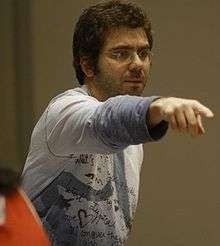Vertixe Sonora Ensemble
Vertixe Sonora Ensemble is a Spanish chamber ensemble founded in 2010 which specializes in contemporary classical music. It was shown in the documentary film Correspondencias Sonoras (2013) by Manuel del Río,[1] and has been directed since its founding by Ramón Souto.
Vertixe Sonora Ensemble | |
|---|---|
Vertixe at the Galician Centre of contemporary Art (CGAC) | |
| Background information | |
| Origin | Spain |
| Genres | contemporary classical music |
| Website | www |
History
The group appeared in 2010 as a flexible collective of soloists who specialize in contemporary classical music.
Repertory
The repertory of Vertixe Sonora Ensemble mainly comprises pieces written specifically for the ensemble. Among the composers who have collaborated with Vertixe are its artistic director Ramón Souto and composers Santiago Díez Fischer, Fernando Garnero,[2] Germán Alonso, Charles-Antoine Fréchette, Bernardo Barros, Marek Poliks, Sabrina Schroeder, Takuto Fukuda, Benjamin Scheuer, Michelle Lou, Santiago Quintáns, Stefan Beyer, Stefan Prins, Miguel Matamoro,[3] Jacobo Gaspar, Esaias Järnegard, Alexander Khubeev, Simone Movio, Matthias Kranebitter,[4] Sergio Blardony,[5] Dmitri Kourliandski, Nadir Vassena, González Compeán, Hernández Ramos,[6] and Mauricio Pauly.[7]

Members
- Rubén Barros, electric guitar
- Pablo Coello, saxophones and music direction
- David Durán and Haruna Takebe, piano
- Ángel Faraldo, electronics
- Carlos Méndez, double bass
- Felipe Agell, clarinets
- Thomas Piel and Ailsa Lewin, violoncello
- Clara Saleiro, flutes
- Diego Ventoso, percussion
References
- http://www.filmaffinity.com/es/film208639.html
- url=http://mixturbcn.com/en/programacio-2015/mixtur-2015-concert-7/
- url=http://cgac.xunta.es/EN/actividad-detalle/62/music-and-art-sound-correspondences
- url=http://vertixesonora.net/causal-2/?lang=en
- http://www.viastellae.org/pdf/2011_programa.pdf
- http://vertixesonora.net/recoleccion-2/?lang=es
- http://www.mundoclasico.com/ed/documentos/doc-ver.aspx?id=63a9ae2f-506e-4b1f-808a-81b8cb7c609d
External links
- Vertixe's website.
- Vertixe at CNDM.
- Full documentary film from sonUTopías 2013.